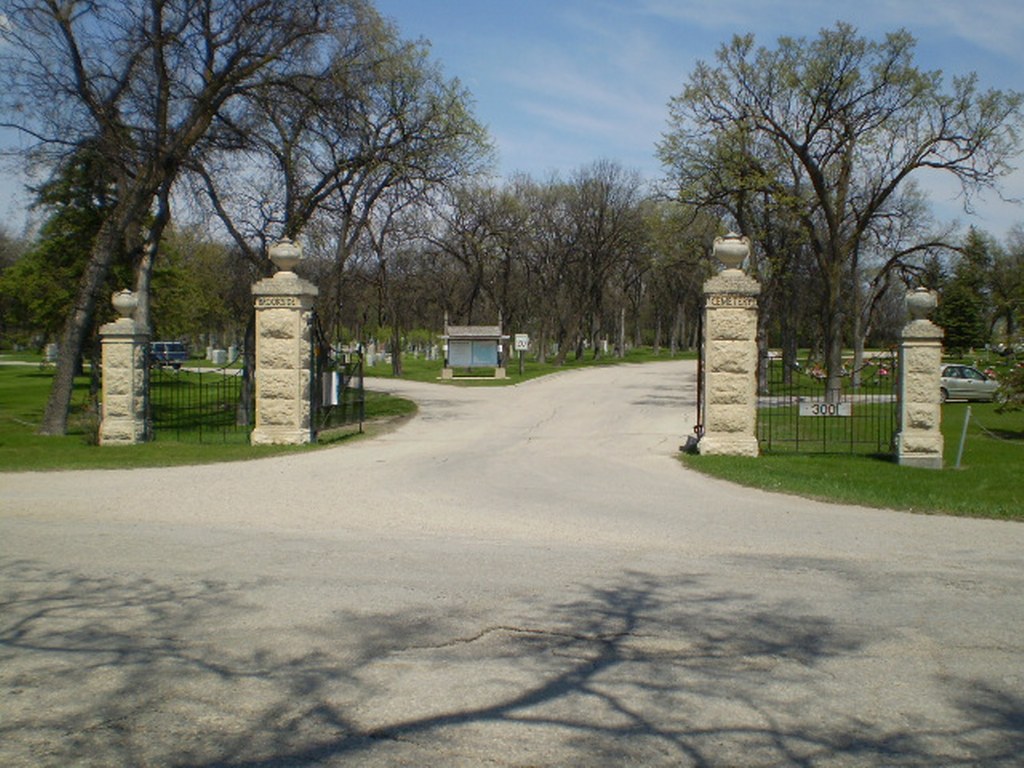Winnipeg (Brookside) Cemetery
- Country Canada
- Total identified casualties 455 Find these casualties
- Region Manitoba
- Identified casualties from First & Second World War
- GPS Coordinates Latitude: 49.91653, Longitude: -97.22103
Location information
The cemetery is adjacent to the Northern Boundary of the Winnipeg International Airport. Access by car Highway 90 (Kenaston Avenue) turn west on Notre Dame Avenue. The cemetery entrance is on your right.
Visiting information
The cemetery grounds are open for visitation from sunrise to sunset.
The on site cemetery office is open Monday to Friday, from 8:30 a.m. to 4:30 p.m.
History information
During the First World War Winnipeg was the headquarters of No 10 Military District and contained six military hospitals with over 970 beds. Air force and army training camps were established in the area during the Second World War, with No 103 Canadian Army Basic Training Centre at Fort Garry. Winnipeg (Brookside) Cemetery contains 300 Commonwealth burials of the First World War and 149 from the Second World War, most of them in the special military plot.
The treatment of the wounded in Winnipeg during the First World War
When Britain declared war against Germany in August 1914, the Canadian government offered its immediate and unequivocal support for the Allied war effort. Over 620,000 Canadians saw military service during the conflict and the Canadian Expeditionary Force played a major role in military operations on the Western Front. Canadian units served with distinction and suffered heavy casualties throughout the war, notably at the battle of Neuve Chapelle in 1915, the battle of the Somme in 1916, and the battles of Vimy Ridge and Passchendaele in 1917. By the time of the Armistice in November 1918, almost 70,000 Canadian soldiers had been killed in action or died of wounds. Most of these men were buried in France and Belgium, but hundreds of badly wounded servicemen who died shortly after being transported back to Canada during the war were buried on Canadian soil.
In 1914 Winnipeg was Canada’s third largest city and one of the fastest growing urban centres in North America. During the war it was the capital of Military District 10 and local men volunteered in large numbers for military service and were posted overseas in regiments such as the Royal Winnipeg Rifles and the Winnipeg Grenadiers. Many civilians, both male and female, were also keen to support the war effort and in 1915 the women of the Imperial Order Daughters of the Empire (IODE) opened a hospital on Broadway and Donald. To begin with the hospital treated men who fell sick or were injured during training in local camps, but as the conflict wore in it was increasingly used to care for and rehabilitate men who had been wounded on the battlefields of the Western Front. As the demand for beds grew with the increased number of patients, the hospital moved to larger premises on Smith Street and in January 1916 it occupied the third floor of the Immigration Hall at Point Douglas.
In June 1916 the Deer Lodge Hospital was established at Silver Heights by the national Military Hospitals Commission and formally opened by the Duchess of Connaught. By the end of the year it was decided that all Canadian servicemen suffering from severe wounds or long-term illness in British hospitals should be transported home and the Commission asked the city to provide a further 1000 beds. In January 1917, the director of the Commission, Senator James Lougheed, visited Winnipeg and outlined the government’s plans to make the city a major centre for the convalescence, recuperation, and rehabilitation of soldiers returning from the European battlefields. In order to deal with the numbers of wounded who flooded into the city in 1917, a new military hospital was established at the former Agricultural College in Tuxedo. The Tuxedo Military Hospital was enlarged in the summer of 1918 and by the end of the war no less than six military hospitals, with a total of over 900 beds, were located in Winnipeg. Almost all of the men who died of wounds or illness while undergoing treatment in these hospitals were buried in the military plot at Brookside Cemetery.







